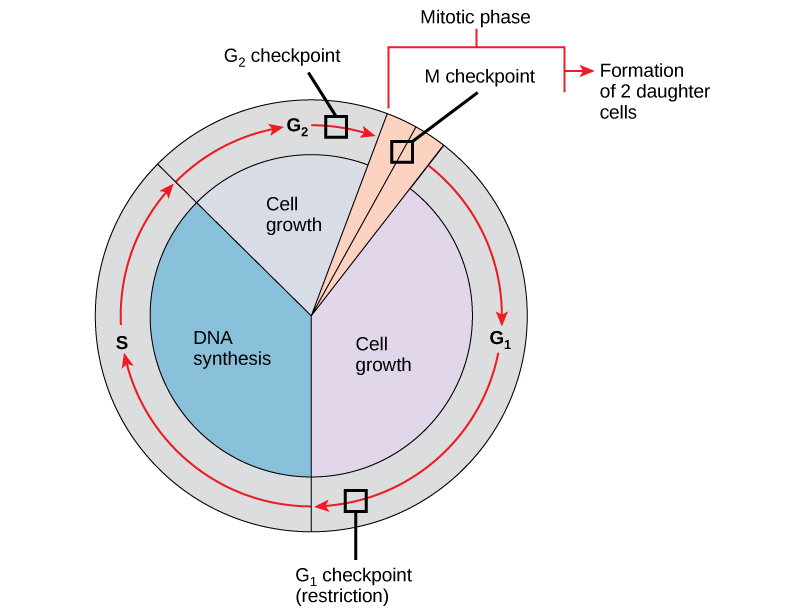The cell cycle is the process a cell undertakes to replicate all of its genetic material and divide into two identical cells. In this article, we will look at the different stages of this and what happens in each stage. We will also consider the regulation of the cell cycle, and look at some examples of its dysregulation.
Phases of the Cell Cycle
The cell cycle is a 4-stage process consisting of Gap 1 (G1), synthesis (S), Gap 2 (G2), and mitosis (M), which a cell undergoes as it grows and divides. After completing the cycle it either starts the process again from G1 or exits through G0. From G0, the cell can undergo terminal differentiation.
The stages between one mitosis and the next, which include G1, S, and G2, are known collectively as the interphase.
G1 phase
- Cell increases in size
- Cellular contents are duplicated
S phase
- DNA replication
- Each of the 46 chromosomes (23 pairs) is replicated by the cell
G2 phase
- Cell grows more
- Organelles and proteins develop in preparation for cell division
M phase
- Mitosis followed by cytokinesis (cell separation)
- Formation of two identical daughter cells
G0 phase
While some cells are constantly dividing, others are quiescent. These cells exit G1 and enter a resting state called G0. In G0, a cell is performing its function without actively preparing to divide. G0 is a permanent state for some cells, while others may re-start division if they get the right signals.
Regulation
The progression of cells through the cell cycle is controlled by various checkpoints at different stages. These detect if a cell contains damaged DNA and ensure those cells do not replicate and divide. The restriction point (R) is located at G1 and is a key checkpoint. The vast majority of cells that pass through the R point will end up completing the entire cycle. Other checkpoints are located at the transitions between G1 and S, and G2 and M.
If damaged DNA is detected at any checkpoint, activation of the checkpoint results in increased p53 protein production. p53 is a tumour suppressor gene that stops the progression of the cell cycle and starts repair mechanisms for the damaged DNA. If this DNA cannot be repaired, it ensures the cell undergoes apoptosis and can no longer replicate.
This cycle is also closely regulated by cyclins which control cell progression by activating cyclin-dependent kinase (CDK) enzymes.
An example of a tumour suppressor protein is retinoblastoma protein (Rb). Rb restricts the ability of a cell to progress from the G1 to the S phase in the cell cycle. CDK phosphorylates Rb to pRb, making it unable to restrict cell proliferation, thereby inhibiting its cell growth-suppressing properties. This allows cells to divide normally.

Fig 2 – Important checkpoints and regulators of the cell cycle
Clinical Relevance – Neoplasia
Neoplasia is a disease of unchecked cell division and its progression is attributed to a change in activity of cell cycle regulators. If a mutation occurs in a protein that regulates the cell cycle, e.g. p53, it can lead to rapid, uncontrolled multiplication of these cells.
When there is a defect in the p53 tumour suppressor gene, it cannot detect and bind to cells with damaged DNA to either repair the damage or cause apoptosis. This leads to unchecked replication of cells and an increase in mutated p53, increasing the risk of neoplasia.

